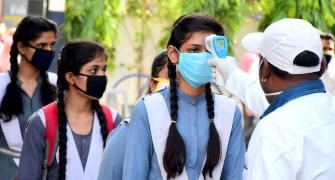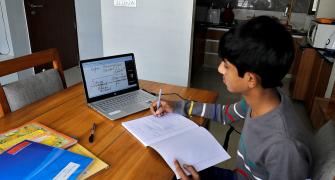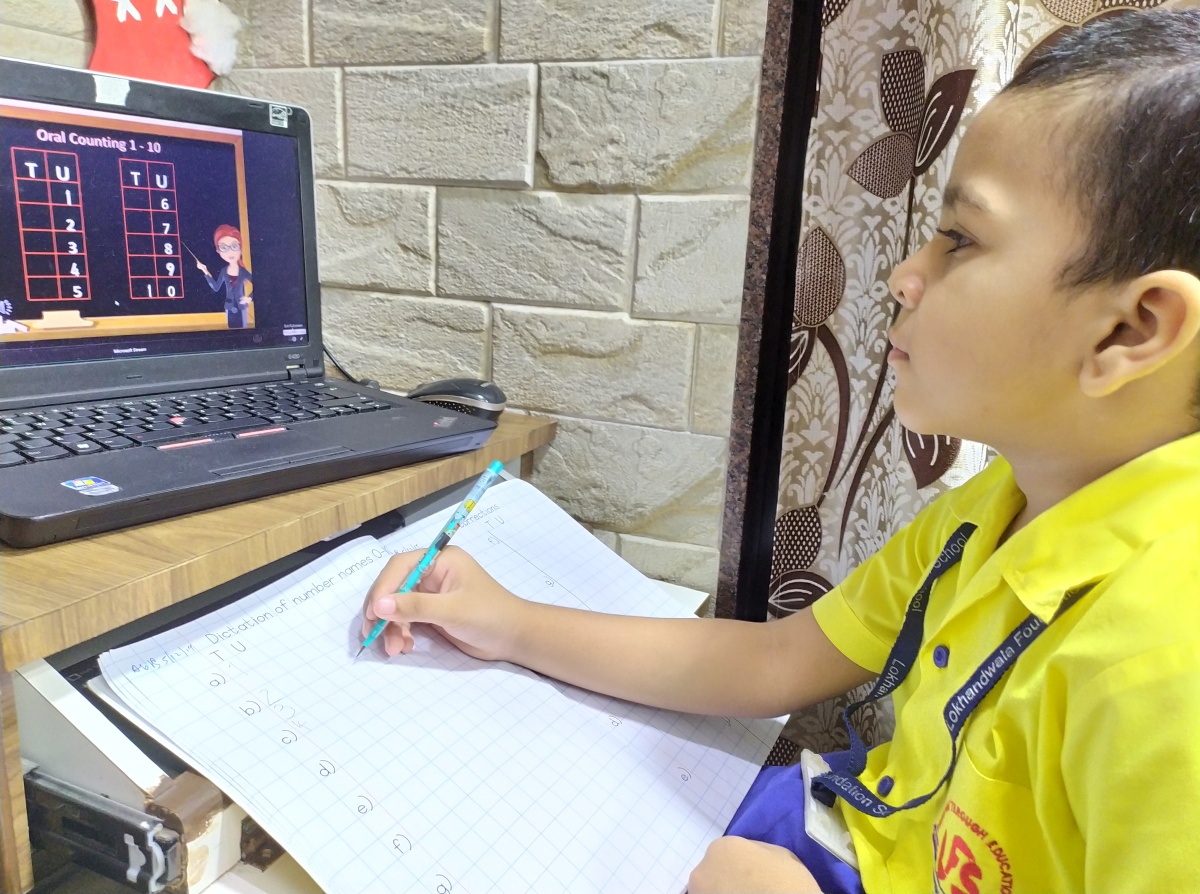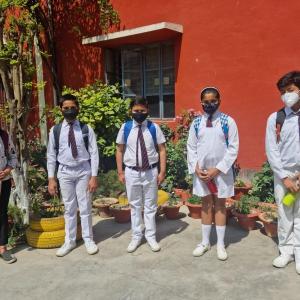'There are large cohorts of students who cannot recognise the alphabet or numbers.'
'We are suggesting schools 'start early and end late'.'

When the coronavirus pandemic broke in March 2020, India's schools and colleges downed shutters.
The closure has extended well beyond everyone's expectations.
Parents are concerned about the learning loss and the impact on children's social and mental well-being.
How do children live without virtually any social interaction for this long?
How long before the negative effects of this take over?
What happens to the age group of 5 to 8 years who have lost very precious formative learning years?
Nationwide, the closure has raised serious questions: What is the relevance of the National Education Policy (NEP), 2019, a report that looked at education before the pandemic struck?
Hasn't reality changed so dramatically since? In this current milieu, how relevant is the new NIPUN (National Initiative for Proficiency in Reading with Understanding and Numeracy) scheme, launched by the government this July for foundational learning?
What happens to students who have fallen behind severely in the interim?
India's learning poverty (the World Bank definition for children unable to read and understand simple text and numbers by the age of 10) was at an alarming 54.8 percent before the pandemic.
Experts fear learning has got worse, though by what number is difficult to say due to India's data paucity.
Argentina, Bangladesh, Cambodia, Jordan, Kuwait and Peru were closest to India in this regard, all ranging in the 50s band whereas China was at 18.2 percent in the same year.
While many of the countries are likely to have seen a rise in learning poverty, India's situation due to its failure to measure its decline accurately or quickly makes it more opaque.
Bikkrama Daulet Singh, co-managing director of Central Square Foundation, spoke to Anjuli Bhargava about the pandemic's fallout on education.
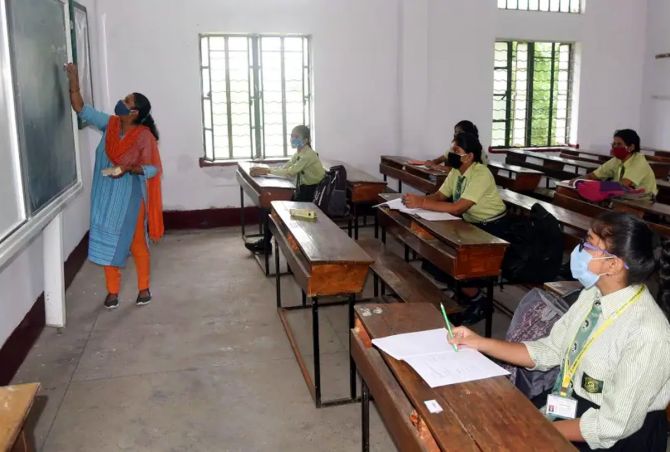
The base year and the situation when NIPUN was operationalised is drastically altered. What relevance does NEP 2019 and NIPUN have in an environment where at least two cohorts of learners (Grade 1 and 2) have missed out almost completely on what they should have?
NIPUN above all, and still, helps all states recognise the problem: what is this learning poverty and why this is important.
Half our children at age 10 cannot read in Hindi, English or regional languages.
I think NIPUN sends the message that we need to tackle this not-so-trivial problem in a mission-oriented manner.
Second, 80%-90% of state education budgets go towards paying salaries.
Programmes that focus on quality are usually funded by central funds.
The ministry has put aside Rs 2,700 crore (Rs 27 billion) a year for foundational learning over the next few years.
A robust FLN programme requires around Rs 500 per child per year (remember you are not paying for the teachers through this).
The big challenge is that it is not status quo.
It may work for the new cohorts in grade 1 and 2, but what happens to the children in primary who have lost two years of learning?
We've been trying to drive home the point that a 60 to 90 day remediation is not going to work.
You can't crunch two years of learning into 2 or 3 months.
Already surveys in the states we work in are showing that there are large cohorts of students who cannot recognise the alphabet or numbers. We are suggesting schools 'start early and end late'.
This means that teachers need to devise a new set of worksheets and curriculum for a grade 3 student that actually begins with grade 1 level work.
For instance, the state of Tamil Nadu has taken the bull by the horns in this by introducing level-aligned textbooks.
They are not giving teachers a choice: They are changing the textbook itself.
Second, the pandemic has demonstrated that home learning can actually help bridge the gap.
The Language and Learning Foundation in Kurukshetra, Haryana, called har ghar school used volunteers who twice weekly went into the community and did classes, distributed worksheets both physically and through WhatsApp groups. It worked quite well.
UP is looking to extend this through the state but through teachers as mobiling so many volunteers may not be possible.

IMAGE: Bikkrama Daulet Singh, co-managing director, Central Square Foundation
Photograph: Kind courtesy Central Square Foundation
NGOs and civil society initiatives can only show the way; they can't solve the problem at a systemic level in a country with such scale.
Yes, the teachers at a macro level need to teach material that is scaffolded back by two years. It cannot be business as usual once schools reopen.
The states we are engaging with -- Tamil Nadu, UP, MP, Haryana --the push we are making is bolder or more ambitious than what other organisations are proposin g.
We are of the view that 60-90 day remediation programmes are simply not enough.
That works when you are three steps below the ladder. But when you have not even started climbing, you cannot fix it in 60 or 90 days.
The teacher needs to alter behaviour and do flexible, iterative work.
We are suggesting that critical components are emphasised and taught.
So if it's a child in Class 3, it's critical he can read sentences of a certain length or say add numbers. So remediation classes are centered around those.
For this, the teachers have to come on board as they are simply conditioned to teach grade level textbooks.
One can expect a push back from teachers, as has been seen in the past with new innovative teaching experiments.
A teacher assigned to grade 3 just picks up the grade 3 textbook and starts teaching regardless of where the students are. This is the conditioning.
So only those state efforts that can mobilise their teachers around this national-level crisis will succeed.
In short, NIPUN can really help the new cohorts coming in, but for the existing ones it will help in fits and starts.
Among the states, Tamil Nadu, of course, is likely to take a lead.
Uttar Pradesh ran some robust home-learning programmes in the pandemic and I am hopeful they will get the design right at least even if not the implementation fully.
Haryana and MP too will get the design right. Implementation is harder to predict.
Which of the NGO-led initiatives have really made a difference in your lens?
The hope with all these is that they switch from civil society to system-led programmes.
Even if the NGO or CSO does the technical, leg or groundwork, it should have the buy-in of the state government.
I think Rocket Learning, LLF and Saarthi all have strong programmes that have demonstrated some degree of success with engagement levels and behavioural changes.
Whether they can be adopted by the state governments at a systemic level remains to be seen.
I do think this (learning improvement) needs to be made into a kind of movement on the lines of a Swaach Bharat mission.
A mission that exhorts teachers and nudges them to ensure they don't leave large cohorts of children behind.
The pandemic has posed a very real threat of a lost generation of learners.
If this can be prioritised at the prime ministerial level, it would grab national attention and some of the losses can be minimised.
Feature Presentation: Rajesh Alva/Rediff.com



